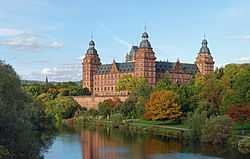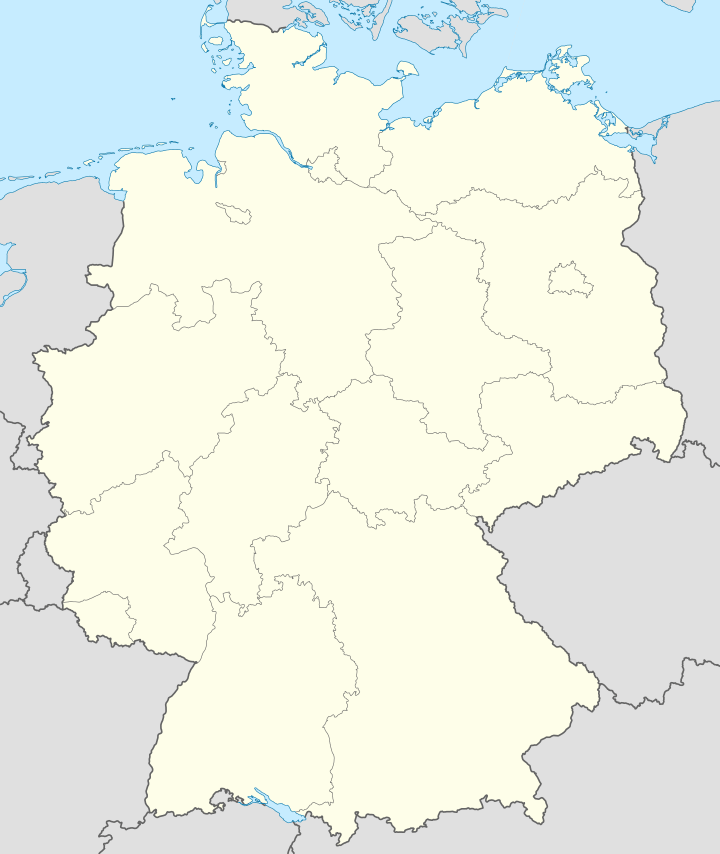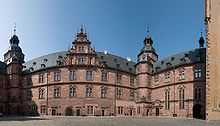Schloss Johannisburg
| Schloss Johannisburg | |
|---|---|
 Schloss Johannisburg in Aschaffenburg | |
 | |
| General information | |
| Architectural style | Renaissance |
| Town or city | Aschaffenburg |
| Country | Germany |
| Coordinates | 49°58′34″N 9°08′28″E / 49.976°N 9.141°E |
| Construction started | 1605 |
| Completed | 1614 |
| Inaugurated | 1614 |
| Client |
Johann Schweikhard von Kronberg Prince Bishop of Mainz |
| Owner | Bayerische Verwaltung der staatlichen Schlösser, Gärten und Seen |
| Design and construction | |
| Architect | Georg Ridinger |

Schloss Johannisburg is a schloss in the town of Aschaffenburg, in Franconia in the state of Bavaria, Germany. It was erected between 1605 and 1614 by the architect Georg Ridinger for Johann Schweikhard von Kronberg, Prince Bishop of Mainz. Until 1803, it was the second residence of the Prince Bishop of Mainz. It is constructed of red sandstone, the typical building material of the Spessart, the hills near Aschaffenburg.
Location
Schloss Johannisburg is located in the city of Aschaffenburg, in the district of Lower Franconia of the state of Bavaria, Germany. It is situated in the center of the city, overlooking the river Main.
History
The palace was erected between 1605 and 1614 by the architect Georg Ridinger for Johann Schweikhard von Kronberg, Prince Bishop of Mainz. A keep from the destroyed 14th-century castle that had formerly stood on the site was included in the construction and is the oldest part of the castle.[1] Until the end of the ecclesial princedoms in Germany in 1803, it was the second residence of the Prince Bishop of Mainz. At the end of the 18th century, the interior had been restructured in the style of Classicism (or Neoclassicism) by Emanuel Herigoyen .[1]
Karl Theodor von Dahlberg, Prince Bishop of Mainz in 1803, retained the territory of Aschaffenburg — turned into the newly created Principality of Aschaffenburg — and was awarded other territories in compensation for Mainz, which was annexed by France. From 1810-1813, Aschaffenburg was part of the Grand Duchy of Frankfurt. Aschaffenburg and Schloss Johannisburg then passed to the Kingdom of Bavaria.
During the reign of Ludwig I, Schloss Johannisburg served as the summer residence of the King, who referred to Aschaffenburg as his "Bavarian Nice". He commissioned the construction of a Roman villa known as Pompejanum within sight of the palace.[2]
The palace was nearly destroyed in the closing days of World War II and took about twenty years to fully restore.[1]
Today
The castle is one of the main attractions of Aschaffenburg and its landmark. Schloss Johannisburg is one of the most important buildings of the Renaissance period in Germany. [1]
Schloss Johannisburg is open to the public and hosts several museums: Staatsgalerie Aschaffenburg, a gallery of paintings (with works by Lucas Cranach the Elder), the Paramentenkammer of the palace chapel (with vestments from the former treasury of Mainz Cathedral), the residential rooms (furnished in Neoclassical style) and the Municipal Palace Museum (arts and handicraft). There is also the world's largest collection of architectural models made from cork, built by court confectioner Carl May and his son after 1792.[3]
References
- ↑ 1.0 1.1 1.2 1.3 "Aschaffenburg - Johannisburg Palace" (PDF). Bayerische Verwaltung der staatlichen Schlösser, Gärten und Seen. Retrieved 17 July 2014.
- ↑ "König Ludwig I (German)". Stadt Aschaffenburg. Retrieved 17 July 2014.
- ↑ "Johannisburg Palace". Bayerische Verwaltung der staatlichen Schlösser, Gärten und Seen. Retrieved 17 July 2014.
External links
| Wikimedia Commons has media related to Schloss Johannisburg. |
- 3D-Model of the Johannisburg Castle that can be displayed in Google Earth
- Official Website of Schloss Johannisburg